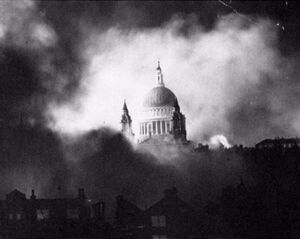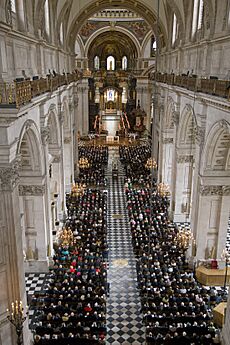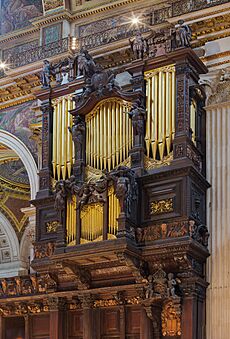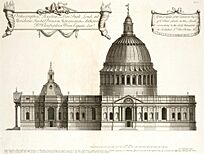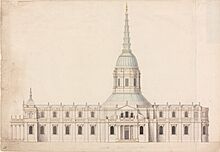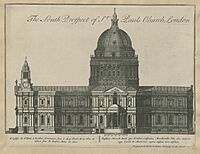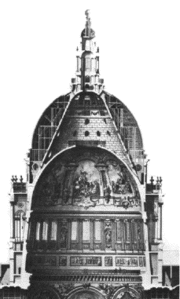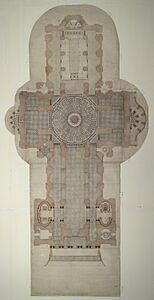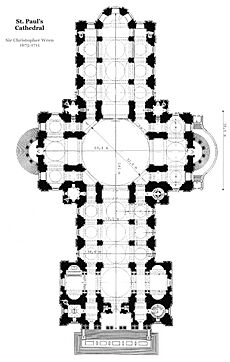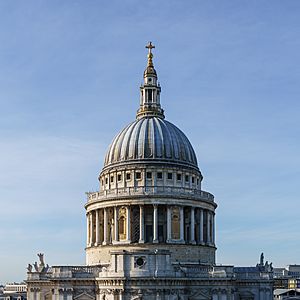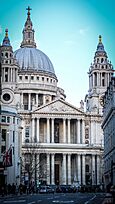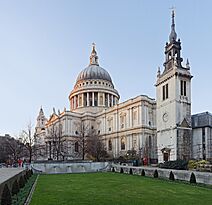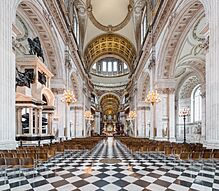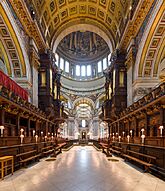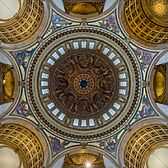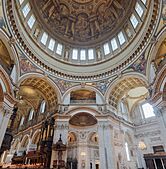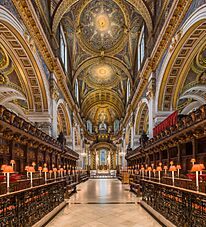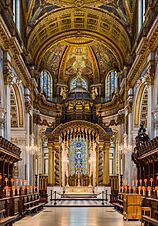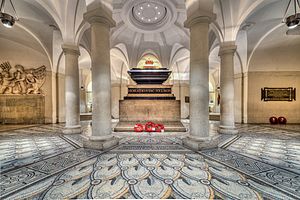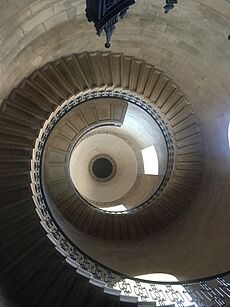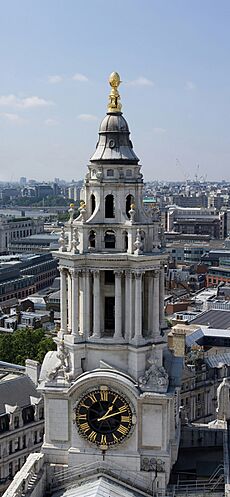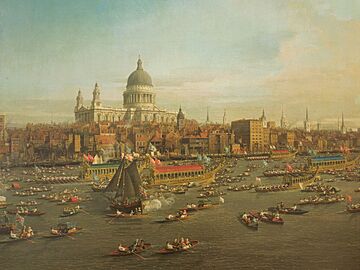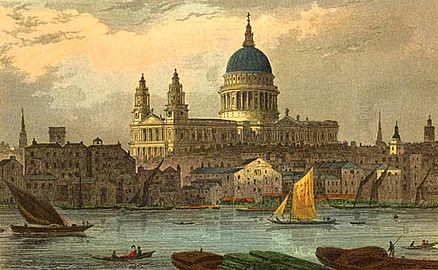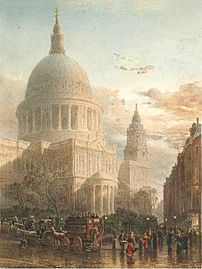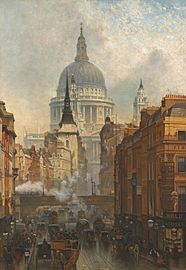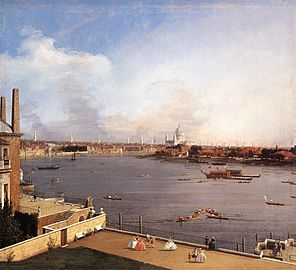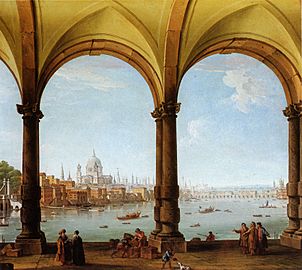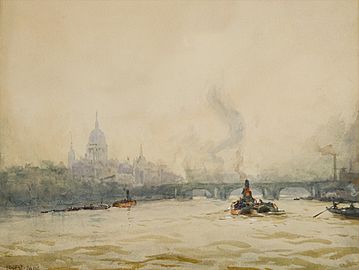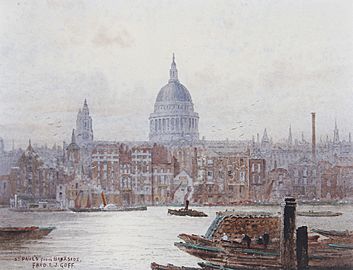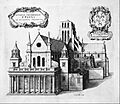St Paul's Cathedral facts for kids
Quick facts for kids St Paul's Cathedral |
|
|---|---|
| Cathedral Church of St Paul the Apostle | |

Aerial view of St Paul's Cathedral
|
|
| 51°30′50″N 0°05′54″W / 51.5138°N 0.0983°W | |
| Location | London, EC4 |
| Country | United Kingdom |
| Denomination | Church of England |
| History | |
| Status | Active |
| Consecrated | 1697 |
| Architecture | |
| Heritage designation | Grade I Listed |
| Previous cathedrals | 4 |
| Architect(s) | Christopher Wren |
| Style | English Baroque |
| Years built | 1675–1710 |
| Groundbreaking | 1675 |
| Completed | 1710 |
| Specifications | |
| Length | 518 ft (158 m) |
| Nave width | 121 ft (37 m) |
| Width across transepts | 246 ft (75 m) |
| Height | 365 ft (111 m) |
| Dome height (outer) | 278 ft (85 m) |
| Dome height (inner) | 225 ft (69 m) |
| Dome diameter (outer) | 112 ft (34 m) |
| Dome diameter (inner) | 102 ft (31 m) |
| Number of towers | 2 |
| Tower height | 221 ft (67 m) |
| Administration | |
| Diocese | London (since 604) |
| Province | Canterbury |
St Paul's Cathedral, also known as the Cathedral Church of St Paul the Apostle, is a famous Anglican church in London, England. It is the main church for the Bishop of London and the Diocese of London within the Church of England. You can find it on Ludgate Hill, which is the highest point in the City of London.
The church has been dedicated to Paul the Apostle since the very first church was built here in AD 604. The current building, with its impressive dome, was finished in 1710. It was designed in the English Baroque style by Sir Christopher Wren. This grand reconstruction happened after the Great Fire of London destroyed the older Gothic cathedral, known as Old St Paul's Cathedral.
St Paul's Cathedral is one of London's most famous landmarks. Its dome has been a key part of the city's skyline for over 300 years. Standing at 365 ft (111 m) tall, it was London's tallest building from 1710 to 1963. Today, its dome is still one of the highest in the world. St Paul's is the second-largest church building in the United Kingdom by area, after Liverpool Cathedral.
Many important events have taken place at St Paul's. These include the funerals of famous figures like Admiral Lord Nelson, the Duke of Wellington, Winston Churchill, and Margaret Thatcher. It also hosted the wedding of Prince Charles and Lady Diana Spencer. The cathedral has held special thanksgiving services for royal events, such as the jubilees of Victoria and Elizabeth II.
St Paul's is a busy church with prayers and services held daily. While there is an entry fee for tourists, people attending services or coming for private prayer can enter for free. The closest London Underground station is St Paul's, which is only about 130 yards (120 m) away.
Contents
History of St Paul's Cathedral
Early Churches on the Site
Before the current St Paul's, there were other churches on or near this spot. Some old stories say there was a Roman temple here, but no proof has ever been found. We know that Christianity was present in London during Roman times.
The first Anglo-Saxon cathedral was built around AD 604 by King Æthelberht of Kent. This church was dedicated to St Paul and became the seat of the first bishop of the East Saxons, Mellitus. This early church was likely on the same site as the later cathedrals.
Over time, this first cathedral faced challenges. After King Sæberht died, his sons, who were not Christian, forced Mellitus out of London. The fate of the first church building is unknown. Christianity returned to the East Saxons later, and it's believed the church was either rebuilt or a new one was constructed. A notable bishop, Erkenwald, who was buried in the cathedral in 693, was highly respected and even became the subject of a medieval poem.
In 1016, King Æthelred the Unready was buried in the cathedral, though his tomb is now lost. The cathedral, along with much of London, was destroyed by a fire in 1087.
Old St Paul's Cathedral
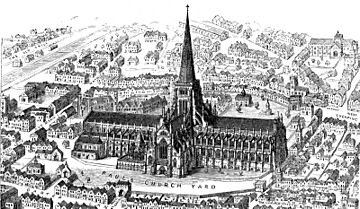
The fourth St Paul's, often called Old St Paul's, was started by the Normans after the 1087 fire. Another fire in 1135 slowed down the work, and the new cathedral wasn't officially opened until 1240. As it was being built, architectural styles changed from Romanesque to Gothic. This meant the later parts of the building had pointed arches and larger windows.
A big expansion began in 1256, and this "New Work" was finished by 1314. In the later Middle Ages, Old St Paul's was one of the longest churches in the world. Its spire was about 489 feet (149 m) tall, making it one of the tallest structures of its time.
During the English Reformation in the 1500s, many changes happened inside the cathedral. Ornaments, chapels, and shrines were removed. The cathedral's collection of holy objects, or relics, was also taken away. These relics included things like parts of saints' bodies and even a knife believed to belong to Jesus.
In 1561, the spire of Old St Paul's was destroyed by a lightning strike. People tried to repair the damage, but it was too expensive. So, the roof was fixed, and a timber structure was put on the steeple instead of the original spire.
In the 1630s, a new front was added to the west side of the building by Inigo Jones, a famous architect. During the English Civil War, the cathedral was damaged by Parliamentarian forces. Many old documents were lost.
Finally, in the Great Fire of London in 1666, Old St Paul's was completely burned out. Even though it might have been possible to rebuild it, the decision was made to construct a brand new cathedral in a modern style.
St Paul's Theatre
From 1575 to 1606, a theatre called St Paul's Theatre operated in the cathedral's Almoner's Hall. It was run by Sebastian Westcott, the cathedral's organist. Young boy choristers from the cathedral performed plays there for paying audiences. This was similar to other "boy companies" of the time.
The Present St Paul's Cathedral
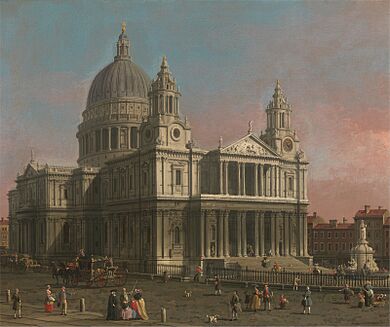
Sir Christopher Wren was officially chosen to design the new cathedral on July 30, 1669. He was already busy rebuilding many other churches in London that were destroyed by the Great Fire.
Wren had actually been advising on repairs to Old St Paul's even before the fire. He had planned to replace its old tower with a dome. After the fire, it was decided to demolish the entire old structure and build something completely new.
The design process for the new St Paul's took several years. Wren's final design was approved, allowing him to make small changes as needed. The result is the magnificent St Paul's Cathedral we see today. It is still the second-largest church in Britain, and its dome is considered one of the finest in the world. The building was paid for by a tax on coal.
The very last stone was placed on the lantern of the dome on October 26, 1708. The cathedral was officially declared complete on Christmas Day, 1711. However, construction continued for a few more years, with statues added to the roof in the 1720s. The total cost was over £1 million.
Consecration
The new cathedral was officially opened for use on December 2, 1697. This was 31 years and 3 months after the Great Fire destroyed Old St Paul's. The Bishop of London, Henry Compton, gave the first sermon.
St Paul's in the 20th and 21st Centuries
Suffragette Attacks
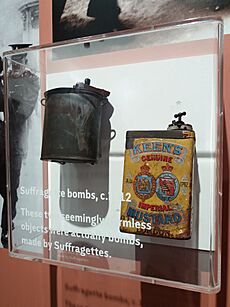
In 1913 and 1914, St Paul's was targeted by suffragettes. These were women who were campaigning for the right to vote. As part of their efforts, they carried out bombings and arson attacks across Britain. They targeted churches because they believed the Church of England was against women getting the vote.
On May 8, 1913, a bomb was found ticking inside St Paul's during a sermon. It was made from a mustard tin and potassium nitrate. Luckily, it was discovered before it could explode. If it had gone off, it would have damaged the historic bishop's throne. The remains of this bomb are now in the City of London Police Museum.
Another bombing attempt happened on June 13, 1914, but this bomb was also found before it could explode.
Major Restoration Work
In the early 1900s, engineers became worried about the dome and its supporting pillars. A large project began in 1925 to strengthen the building. Concrete and steel bars were put into the pillars, and a huge steel chain was placed around the outside of the dome to make it stable. The work was finished in 1930, and a special service was held, attended by King George V and Queen Mary. This service was the first time worship from the cathedral was broadcast on BBC Radio.
Surviving World War II
St Paul's Cathedral survived the Blitz, the heavy bombing of London during World War II. It was hit by bombs on October 10, 1940, and April 17, 1941. The first bomb destroyed the main altar. The second bomb hit the north side, leaving a hole in the floor above the crypt.
On September 12, 1940, a time-delayed bomb hit the cathedral. If it had exploded, it would have completely destroyed the building. However, a brave team of Royal Engineers led by Temporary Lieutenant Robert Davies successfully defused and removed it. For their bravery, Davies and Sapper George Cameron Wylie were awarded the George Cross.
One of the most famous images of London during the war is a photograph of St Paul's taken on December 29, 1940. It shows the cathedral's dome rising through clouds of smoke and fire. This image became a symbol of hope and strength for the British people. Prime Minister Winston Churchill even ordered that all firefighting efforts should focus on saving St Paul's because he believed it was vital for the country's morale.
After the War
After World War II, a lot of rebuilding and repair work was done in the 1950s and 1960s. This included restoring the high altar and the American Memorial Chapel, which was completed in 1958.
On July 29, 1981, the wedding of Prince Charles and Lady Diana Spencer took place at the cathedral. They chose St Paul's over Westminster Abbey because it had more seating for guests.
A major 15-year restoration project, one of the largest in the UK, was completed on June 15, 2011.
Occupy London Protest
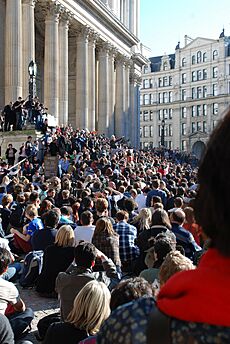
In October 2011, a protest group called Occupy London set up a camp in front of the cathedral. This led to the cathedral being closed for a time, which affected its income. The protest camp was eventually removed peacefully in February 2012 by court order.
2019 Terrorist Plot
On October 10, 2019, a person named Safiyya Amira Shaikh was arrested after planning to attack St Paul's Cathedral and other places with explosives. She pleaded guilty and was sentenced to life imprisonment.
National Events at St Paul's
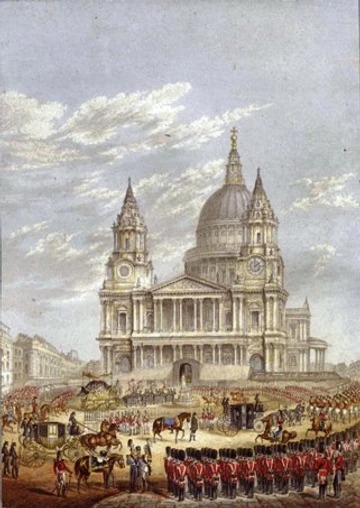
St Paul's Cathedral is a perfect place for important national events because of its large size and grand design. Its wide steps, huge nave, and the space under the dome are great for ceremonies. The cathedral can hold many more people than any other church in London. In the past, temporary wooden seating allowed over 10,000 people to attend.
Many national events attended by the royal family and government leaders have taken place here. Some of the most famous include:
- The state funeral of Horatio Nelson in 1806.
- The state funeral of the Duke of Wellington in 1852.
- Thanksgiving services for the end of World War I (1919) and World War II (1945).
- The state funeral of Winston Churchill in 1965.
- The Silver Jubilee of Elizabeth II in 1977.
- The Wedding of Prince Charles and Lady Diana Spencer in 1981.
- The Golden Jubilee of Elizabeth II in 2002.
- The Diamond Jubilee of Elizabeth II in 2012.
- The ceremonial funeral of Margaret Thatcher in 2013.
- A thanksgiving service for Queen Elizabeth II's 90th birthday in 2016.
- The Platinum Jubilee National Service of Thanksgiving in 2022.
How St Paul's Works Today
St Paul's Cathedral is a busy church with several services every day, including morning prayers, Holy Communion, and evening prayers. It also hosts many special services for the City of London and its various groups. As London's largest church, it plays a role in many state events, like the service celebrating Queen Elizabeth II's Diamond Jubilee. The cathedral is usually open daily for visitors and has a regular schedule of organ concerts and other performances. The current Bishop of London is Sarah Mullally, who started her role in May 2018.
Cathedral Leadership
The cathedral is run by a group of people called the cathedral chapter. This group includes the dean, who is the head of the cathedral, and several canons, who each have different responsibilities. The current Dean is Andrew Tremlett, who started in September 2022.
Music at St Paul's
The Director of Music is Andrew Carwood, who started in September 2007. He is the first person in this role since the 12th century who is not an organist.
Organs
St Paul's has a very large organ, built by Bernard Smith in 1694. It is the fifth-largest organ in Great Britain, with 7,256 pipes. It has 5 keyboards and 137 different sounds. The organ case was designed in Christopher Wren's workshop and decorated by Grinling Gibbons.
Choir
St Paul's Cathedral has a professional choir that sings regularly at services. Records of the choir go back to 1127. Historically, the choir had up to 30 boy choristers and 12 professional male singers.
In February 2017, the cathedral welcomed its first female professional singer, Carris Jones. A big change happened in 2022 when St Paul's announced that girls would be allowed to join its choir, breaking a 900-year tradition. On June 30, 2024, two girls officially joined the choir as full choristers, marking a historic moment.
The choir sings most days during school terms. On Sundays, they sing for morning prayers and the main Holy Communion service. Many famous musicians have been organists, choir masters, and choristers at St Paul's, including composers like Thomas Morley and John Blow.
Wren's Amazing Design
How the Design Developed
Designing St Paul's was a huge challenge for Christopher Wren. He needed to create a grand cathedral that would replace the old one and be a landmark for London. He also had to please the church and the King, while still respecting the traditional style of English churches. Wren knew a lot about new architectural styles from Italy and France.
Wren's design went through several stages. His first idea was a circular building with a dome, but it was thought not to be grand enough. His second design was shaped like a Greek cross, but the church leaders felt it didn't fit their services.
Wren's third design is shown in the "Great Model" from 1673. This large model, made of oak and plaster, cost a lot of money. This design kept the Greek-Cross shape but added a long main hall (nave). However, critics said it was too different from other English churches. Also, the whole building would have to be finished at once, which was difficult. Wren loved this design, but after it was rejected, he decided not to make any more models.
Wren's fourth design is called the Warrant design because it received royal approval. This design was more like a traditional medieval cathedral, shaped like a Latin Cross. It had classical entrances at the front and sides. The dome was designed to have a tall spire on top. This plan was slightly angled to align with the sunrise on Easter when construction began, showing Wren's interest in astronomy.
The Final Design
The cathedral as it was built looks quite different from the official Warrant design. Wren was given permission to make "ornamental changes," and he used this freedom a lot. Many changes happened during the 30 years of construction, especially to the dome. Wren added a brick cone between the inner and outer domes to support the heavy stone lantern on top. This cone is hidden from view. The final design was inspired by St. Peter's Basilica in Rome.
The first stone of the cathedral was laid in June 1675.
How it was Built
Wren faced the challenge of building a huge cathedral on London's soft clay soil. St Paul's is special because it has a very large crypt, or underground area, beneath the entire building. This crypt helps support the massive weight of the church above. Instead of just four pillars, Wren designed the dome to be supported by eight pillars, spreading the weight more evenly.
One of Wren's biggest challenges was designing a dome that looked impressive from both the outside and the inside. He created a double-shelled dome, like at St Peter's Basilica. The inner dome is lower, and the outer dome is much taller. Between them, there's a brick cone that supports the outer dome and the heavy lantern on top. Both the cone and the inner dome are very strong, with iron chains to prevent cracks.
Wren also made the cathedral walls very thick so that external supports (buttresses) weren't needed. However, hidden flying buttresses were added later to give extra strength to the upper walls. These are hidden behind the outer screen wall, which also helps balance the look of the dome.
Builders and Artists
Many skilled people worked on St Paul's. Nicholas Hawksmoor was Wren's main assistant. Master masons like Thomas and Edward Strong worked on the construction for the entire time. Grinling Gibbons was the chief sculptor, creating beautiful stone carvings on the outside and wood carvings inside. Francis Bird made the large statues on the west front. The floor was paved with black and white marble. Jean Tijou created the amazing wrought iron gates and railings.
After the war damage, many craftsmen helped restore the building. One notable carver, Gino Masero, created the new eight-foot sculpture of Christ for the High Altar.
Inside and Out: A Look at St Paul's
St Paul's Cathedral is built in a calm Baroque style. Wren combined traditional English church building with ideas from Italian and French architecture. The layout of St Paul's is similar to medieval cathedrals, with a long main hall (nave) and wide side sections (transepts).
Outside the Cathedral
The most famous part of St Paul's is its dome, which reaches 365 feet (111 m) to the cross at its very top. It dominates the London skyline. Until the late 20th century, St Paul's was the tallest building in the city. Experts describe the dome as "probably the finest in Europe" and "one of the most perfect in the world."
The Dome
Wren got ideas for the dome from St Peter's Basilica in Rome. St Paul's dome rises in two clear stone sections. Around the base of the dome is a continuous row of columns, called a peristyle. This helps support both the inner dome and the brick cone inside.
Above the columns is a balcony called the "Stone Gallery." Above this, the dome itself is covered with lead and has ribs that match the columns below. Just below the lantern, there are eight hidden windows that let light into the space between the domes.
The lantern, the structure on top of the dome, also rises in sections. It's unusual because it's square, not round. The very top has a small dome with a cross on a golden ball. The lantern weighs about 850 tons.
The West Front
The west front, or main entrance, of St Paul's has a grand classical entrance with two stories and paired columns. The lower part of this entrance stretches across the full width of the building.
The two towers on either side of the west front stand out from the main building. The lower parts of the towers have small, deeply set windows, showing how thick the walls are. Above the main decorative band, the towers rise from square bases. They are made of a central round section with paired columns at the corners. The very top of each tower has a dome shape with a golden pineapple decoration.
The side entrances, called transepts, each have a curved entrance. These curved shapes match the curved end of the building at the east.
The Walls
The cathedral is built with two layers of stone blocks, above a basement. A decorative railing, called a balustrade, runs along the top of the upper level. This balustrade was added in 1718, even though Wren didn't want it.
The outside walls have paired columns with fancy tops. Where the building inside is only one story tall (like the side aisles), the upper story of the outer wall is just for show. It helps support the hidden buttresses and makes the building look grand from a distance.
Between the columns are windows. The lower windows have rounded tops and beautiful stone carvings of flowers by Grinling Gibbons. These are some of the best stone carvings in England. The upper windows are decorative and contain empty spaces for statues.
Fencing
The original fence around the cathedral, designed by Wren, was taken down in the 1870s. It was then shipped to Toronto, Canada, where it now decorates High Park.
Inside the Cathedral
Inside, St Paul's has a long main hall (nave) and a choir area. The entrance from the west leads into a square hall with a dome, flanked by two chapels. The nave is 91 feet (28 m) tall. Its ceiling has saucer-shaped domes. The choir area has beautiful mosaics by Sir William Blake Richmond.
The main space inside the cathedral is under the central dome. The dome is supported by eight arches. Above these arches, at 99 feet (30 m) above the floor, is the Whispering Gallery. If you whisper against the wall here, someone on the other side of the gallery can hear you! You can reach it by climbing 259 steps.
The Dome Interior
The inside of the dome is decorated with paintings by Sir James Thornhill. These paintings show eight scenes from the life of St Paul and look like they are part of the building's architecture. At the very top of the dome is a round opening, like the one in the Pantheon in Rome. Through this opening, you can see the decorated inner surface of the hidden brick cone.
The Apse
The eastern end of the cathedral, called the apse, is decorated with mosaics. The original main altar was destroyed by bombing in 1940. The current high altar was designed by W. Godfrey Allen and Stephen Dykes Bower. The apse was dedicated in 1958 as the American Memorial Chapel. It honors over 28,000 Americans who died while serving in the United Kingdom during World War II.
Artworks, Tombs, and Memorials
St Paul's is filled with beautiful art. Besides the carvings by Grinling Gibbons and paintings by Thornhill, there are mosaics by Sir William Richmond. In the south aisle, you can see William Holman Hunt's painting The Light of the World. In the north choir aisle, there is a stone sculpture of the Madonna and Child by Henry Moore.
The crypt, the large underground area, holds over 200 memorials and many burials. Christopher Wren was the first person buried here in 1723. Above his tomb, a Latin inscription reads: Lector, si monumentum requiris, circumspice ("Reader, if you seek his monument, look around you").
The largest monument in the cathedral is for the Duke of Wellington, created by Alfred Stevens. It stands in the nave and features a statue of Wellington on his horse. Wellington himself is buried in the crypt.
The tomb of Horatio, Lord Nelson is also in the crypt, next to Wellington's. His marble coffin was originally made for Cardinal Wolsey but was never used by him.
The crypt also contains the Chapel of the Order of the British Empire, created in 1917. There are many other memorials to British military members, including lists of those who died in conflicts like the Gulf War.
Other famous people remembered here include Florence Nightingale, J. M. W. Turner, and Alexander Fleming. One unique sculpture is that of the Dean and poet, John Donne. He posed for his own memorial before he died, and it shows him wrapped in a burial shroud. This sculpture is the only one that survived the Great Fire of 1666 intact.
The cathedral's treasury is also in the crypt, but it has very few original treasures. Many were lost, and a major robbery in 1810 took almost all the remaining valuable items.
The East India Company Trail
In 2023, St Paul's Cathedral started a project to explain the history behind some of its memorial statues. Many statues honor people who were involved with the British Empire, including its less positive aspects like slavery. The "East India Company Trail" provides information that helps visitors understand the full historical context of these statues. You can find these explanations on the cathedral's website and by scanning QR codes next to the statues.
Geometric Staircase
The Geometric Staircase is a beautiful spiral staircase in the southwest tower. It rises 50 feet (15 m) with 88 stone steps. Designed by Christopher Wren, it was built by William Kempster and finished in 1710. The steps are mostly supported by the steps below them, making it a clever design. This staircase has appeared in several movies.
The Clock and Bells
A clock was installed in the southwest tower in 1709. The current clock mechanism was built in 1893. Since 1969, the clock has been wound electrically.
Great Paul
The southwest tower also holds four bells. One of them is Great Paul, cast in 1881. At 16+1⁄2 long tons (16,800 kg), it was the largest bell in the British Isles until 2012. Great Paul had not been rung for many years because its chiming mechanism was broken. However, on July 31, 2021, it rang for the first time in two decades, swung by hand by bell ringers.
Great Tom
Another clock bell is Great Tom. It was moved from the Palace of Westminster and has been recast several times. It chimes the hour and is traditionally rung when a member of the royal family, the Bishop of London, or the Lord Mayor of London dies. It was last rung for the death of Queen Elizabeth II in 2022, ringing once every minute for her 96 years of life.
Quarter-jacks
In 1717, two more bells were added that ring every 15 minutes. They are sometimes called Ding and Dong because of their sound.
Bells for Change Ringing
The northwest tower has 13 bells. Twelve of these are used for change ringing, a special way of ringing bells in a pattern. These bells were removed for refurbishment in January 2018 and rehung in September of that year. The 13th bell is a single communion bell, known as "the Banger," which is rung before early morning services.
| Bell (Name) | Weight | Nominal Hz |
Note | Diameter | Date cast |
Founder | |||
|---|---|---|---|---|---|---|---|---|---|
| (long measure) | (lb) | (kg) | (in) | (cm) | |||||
| 1 | 8 long cwt 1 qr 4 lb | 928 | 421 | 1,461 | F | 30.88 | 78.4 | 1878 | John Taylor & Co |
| 2 | 9 long cwt 0 qr 20 lb | 1,028 | 466 | 1,270 | E♭ | 32.50 | 82.6 | 1878 | John Taylor & Co |
| 3 | 9 long cwt 3 qr 12 lb | 1,104 | 501 | 1,199 | D | 34.00 | 86.4 | 1878 | John Taylor & Co |
| 4 | 11 long cwt 2 qr 22 lb | 1,310 | 594 | 1,063 | C | 36.38 | 92.4 | 1878 | John Taylor & Co |
| 5 | 13 long cwt 1 qr 0 lb | 1,484 | 673 | 954 | B♭ | 38.63 | 98.1 | 1878 | John Taylor & Co |
| 6 | 13 long cwt 2 qr 14 lb | 1,526 | 692 | 884 | A | 39.63 | 100.7 | 1878 | John Taylor & Co |
| 7 | 16 long cwt 1 qr 18 lb | 1,838 | 834 | 784 | G | 43.75 | 111.1 | 1878 | John Taylor & Co |
| 8 | 21 long cwt 3 qr 18 lb | 2,454 | 1,113 | 705 | F | 47.63 | 121.0 | 1878 | John Taylor & Co |
| 9 | 27 long cwt 1 qr 22 lb | 3,074 | 1,394 | 636 | E♭ | 52.50 | 133.4 | 1878 | John Taylor & Co |
| 10 | 29 long cwt 3 qr 21 lb | 3,353 | 1,521 | 592 | D | 55.25 | 140.3 | 1878 | John Taylor & Co |
| 11 | 43 long cwt 2 qr 0 lb | 4,872 | 2,210 | 525 | C | 61.25 | 155.6 | 1878 | John Taylor & Co |
| 12 | 61 long cwt 2 qr 12 lb | 6,900 | 3,130 | 468 | B♭ | 69.00 | 175.3 | 1878 | John Taylor & Co |
| Clock (quarter-jack Ding) | 12 long cwt 2 qr 9 lb | 1,409 | 639 | 853 | A♭ | 1707 | Richard Phelps | ||
| Clock (quarter-jack Dong) | 24 long cwt 2 qr 26 lb | 2,770 | 1,256 | 622 | E♭ | 1707 | Richard Phelps | ||
| Clock (Great Tom) | 102 long cwt 1 qr 22 lb | 11,474 | 5,205 | 425 | A♭ | 82.88 | 210.5 | 1716 | Richard Phelps |
| Bourdon (Great Paul) | 334 long cwt 2 qr 19 lb | 37,483 | 17,002 | 317 | E♭ | 114.75 | 291.5 | 1881 | John Taylor & Co |
| Communion (The Banger) | 18 long cwt 2 qr 26 lb | 2,098 | 952 | 620 | E♭ | 49.50 | 125.7 | 1700 | Philip Wightman |
Visiting St Paul's Cathedral
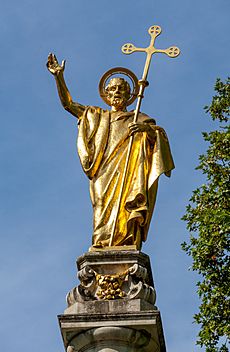
Learning About St Paul's
St Paul's has worked to make its history come alive for visitors. In 2010, they opened St Paul's Oculus, a 270-degree film that showed 1400 years of the cathedral's history. This was located in the crypt.
Also in 2010, touchscreen guides were introduced. These guides are included with admission and help visitors learn about the cathedral's history, architecture, and daily life. They are available in 12 languages and include videos and interviews with experts.
Entrance Fees
St Paul's charges an entrance fee for tourists. However, if you are coming to attend a worship service, there is no charge. On Sundays, the cathedral is only open for services and concerts, and there is no sightseeing. The fees help pay for the cathedral's upkeep and allow it to continue as a place of worship, as it receives little funding from the government or the Church of England.
Art at St Paul's
The St Paul's Cathedral Arts Project brings together art and faith. It has featured works by famous artists like Antony Gormley and Yoko Ono.
In 2014, artist Gerry Judah created two sculptures in the nave to mark 100 years since the start of World War I. These sculptures looked like white crosses and also included small models of destroyed buildings from modern war zones, connecting past and present conflicts.
Bill Viola created two permanent video artworks for the cathedral, showing scenes from the lives of Mary and martyrs. These multi-screen videos are located near the High Altar.
In 2010, two large red artworks by Mark Alexander were hung in the nave. They were inspired by a damaged altarpiece from a German cathedral. Also in 2010, a sculpture called Flare II by Antony Gormley was placed in the Geometric Staircase.
In 2007, artist Martin Firrell created a public artwork called "The Question Mark Inside." It projected text onto the dome and other parts of the cathedral. The text shared ideas about what makes life meaningful.
St Paul's in Art and Media
St Paul's Cathedral has been painted, drawn, and photographed many times. Famous artists like Canaletto and Turner have captured its beauty. The iconic photo of the dome surrounded by smoke during the Blitz is particularly well-known.
- Paintings and engravings of St Paul's
-
Canaletto: The River Thames with St. Paul's Cathedral on Lord Mayor's Day (1746)
-
Oil painting, John O'Connor, Evening on Ludgate Hill (1887)
The cathedral has also appeared in many films and TV shows:
- St. Paul's Cathedral (1942), a wartime documentary.
- Lawrence of Arabia (1962) shows the outside of the building.
- Mary Poppins (1964) features the steps and west front for the song '"Feed the Birds'".
- It has appeared twice in Doctor Who, in "The Invasion" (1968) and "Dark Water"/"Death in Heaven" (2014), where the Cybermen are seen outside.
- In the Goodies episode "Kitten Kong" (1971), the dome is knocked off.
- In "A Guide to Armageddon" (1982), St Paul's is used as the center point for a nuclear explosion simulation.
- Lifeforce (1985) uses the cathedral's interior for its ending.
- The Madness of King George (1994) shows the Geometric Staircase.
- Tomb Raider III (1998) features St Paul's as a playable location, though the dome appears destroyed in that version. The 2024 remastered version fixed this.
- Harry Potter and the Prisoner of Azkaban (2004) shows the Geometric Staircase as a staircase in Hogwarts.
- Star Trek Into Darkness (2013) shows St Paul's in a future London.
- In the film Mortal Engines (2018), St Paul's is the only old London building to survive a future war.
Images for kids
-
Shrine of St Erkenwald, whose relics were removed in 1550. The monument was lost in the Great Fire of London.
-
Old St Paul's in 1656 by Wenceslaus Hollar, showing the rebuilt west façade.
See also
 In Spanish: Catedral de San Pablo (Londres) para niños
In Spanish: Catedral de San Pablo (Londres) para niños



